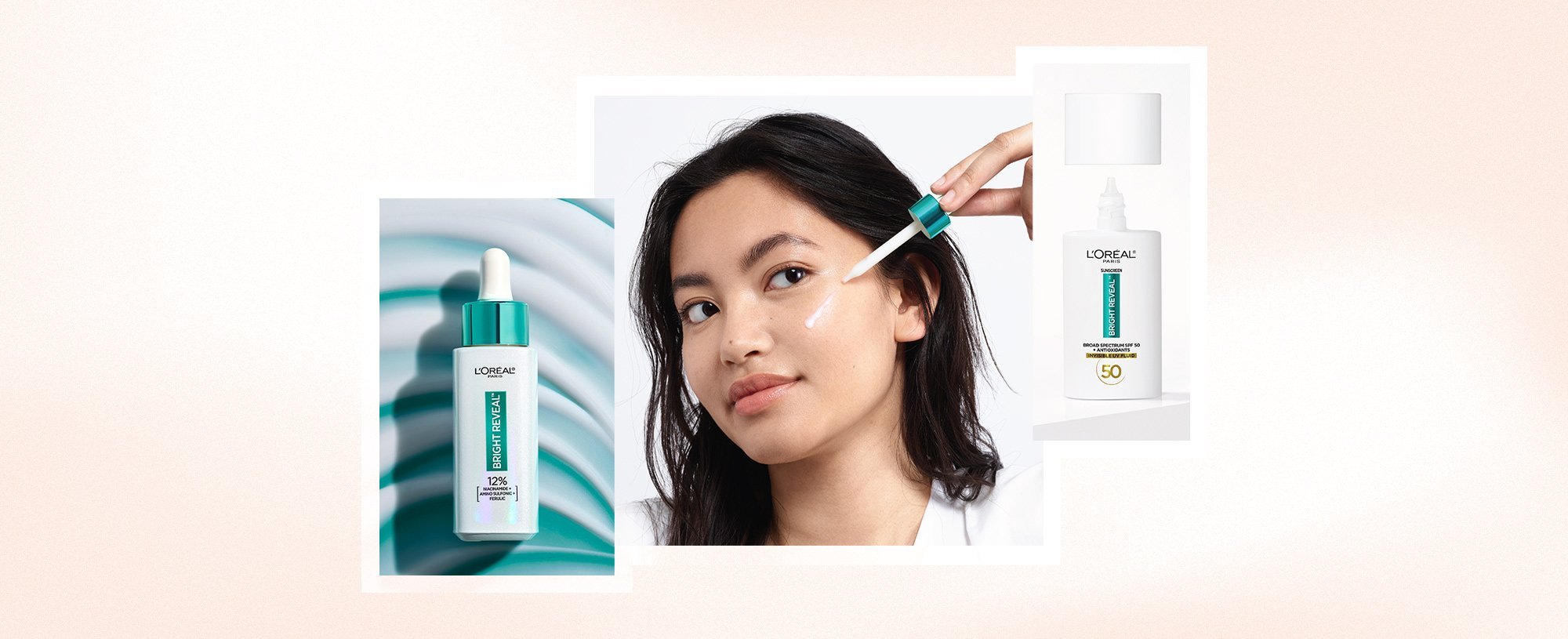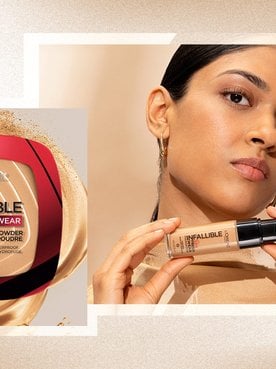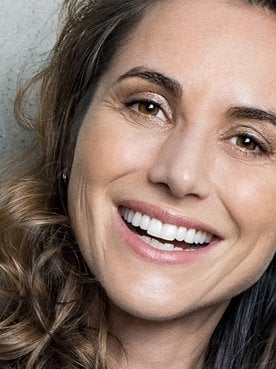Managing dark spots on the face is a marathon, not a sprint. There are few things that are as frustrating as finally getting rid of a blemish only to discover a stubborn dark spot has taken its place. It takes more than your regular shower to get them off. Keeping your skin tone clear requires maintaining a consistent and targeted skincare routine (and avoiding the triggers that can cause discoloration, such as hyperpigmentation).
To learn more about dark spots on the skin and, most importantly, what you can do about them, we tapped Michelle Henry MD, FAAD, a board-certified dermatologist and L’Oréal Paris consultant. And what we found out was indeed illuminating.
What Are Dark Spots?
Dark spots are quite literally what they sound like—small patches of discoloration that are darker than your regular skin tone. They occur when the pigment that gives skin its color, melanin, goes into overdrive. While dark spots can appear on anyone, people with medium to dark skin tones are especially prone to developing them.
Dark spots and hyperpigmentation are two terms that are often used interchangeably, but they aren’t always quite the same thing. “All hyperpigmentation is dark by definition, but not all hyperpigmentation is a spot,” says Dr. Henry. For instance, “Melasma is a wide irregular patch across the face,” she points out. “It’s not a spot, but it’s dark and a type of hyperpigmentation.”
Types of skin darkening and causes
- Age spots (a.k.a. sunspots or liver spots) result from sun damage, which is why they usually pop up on skin that’s frequently exposed to the sun, like your face, hands, and shoulders.
- Freckles are small brown spots that can occur anywhere on the body, though they tend to develop on the face and arms. These small spots are genetic and, unlike other types of dark spots, are most common on those with fairer skin.
- Melasma, as Dr. Henry mentioned, is a type of discoloration that results in larger dark spots or patches. It’s typically caused by hormonal changes (like pregnancy) and can develop on the cheeks, forehead, across the nose, or just above the upper lip.
- Post-inflammatory hyperpigmentation develops after injury or irritation to the skin (acne and bug bites are common causes). The discoloration occurs only where the original irritation was, resulting in a small, localized dark spot.
Editor’s note: No matter the cause, all dark spots on the skin can become darker and more pronounced when they’re exposed to the sun. Keeping your skin protected from the sun is one of the best ways to help minimize the appearance of dark spots (and prevent future spots from developing).
What Vitamin Deficiency Causes Dark Spots?
Dark spots on the face can be linked to deficiencies in Vitamin B12 and folic acid. These vitamins play a crucial role in skin health and cell regeneration, and a lack of them can lead to the development of hyperpigmentation. Vitamin B12 deficiency, in particular, may cause uneven skin tone, while a lack of folic acid can contribute to darker spots. Additionally, vitamins like Vitamin C and Vitamin E help maintain an even skin tone by protecting against oxidative damage and promoting collagen production, which is essential for healthy, balanced skin.
Skincare Ingredients for Dark Spots
Dark spots on the face and body skin can be stubborn, which may explain why they’re one of the most common skin issues people seek help for. Fortunately, certain skincare ingredients can help improve the look of them. While there’s no surefire way to remove dark spots entirely, the following ingredients can help them become less noticeable over time and help you lighten dark spots on the face.
1. Niacinamide
If you’re looking to treat dark spots on the face and promote a more even skin tone, consider adding niacinamide to your skincare routine. Studies have found that this naturally occurring form of vitamin B3 can help lighten dark spots and other types of discolorations on the face and body when used topically. In addition to its dark spot-lightening benefits, niacinamide can help soothe irritation, increase skin hydration, and reduce the appearance of enlarged pores. It even shows promising anti-aging properties—like helping to improve the look of fine lines and wrinkles. Plus, it’s known to play well with other skincare ingredients, such as glycolic acid, hyaluronic acid, vitamin C, and retinol.
You can find this powerful ingredient in L’Oréal Paris Dark Spot Exfoliant Peel. This dermatologist-validated formula helps reduce the appearance of all types of dark spots and gently exfoliates to reveal brighter-looking skin. You just have to apply, leave for 15 min, and rinse. Your skin will start to look more even in just a couple of weeks' time, and dark spots will be less visible with continued use. Plus, the lightweight peel is suitable for all skin types and even sensitive skin. One of the most effective solutions when looking to lighten dark spots on the face.

2. Vitamin C
Vitamin C (a.k.a. ascorbic acid or L-ascorbic acid) is also known for helping to improve the appearance of dark spots. This powerful antioxidant helps protect your skin from free radicals and sun damage, which can accelerate skin aging and cause dark spots on face and body skin. When used consistently, products with vitamin C may help fade dark spots while making your skin look brighter, smoother, and more radiant overall. Bonus: it’s also useful for tackling other age-related concerns, such as dark under-eye circles, fine lines, and wrinkles.
3. Retinol
While retinol is best known for its anti-aging benefits, the powerful vitamin A derivative can also help improve the appearance of dark spots. When used topically, retinol helps exfoliate the skin, which contributes to a brighter, more even-looking appearance over time. By exfoliating the skin, retinol may also help to keep clogged pores (and, by extension, breakouts) to a minimum, as well—so it can be used to both treat dark spots and help prevent them.
Keep in mind, however, that retinol can cause dryness when you first start using it, especially if you’re sensitive. If you’ve never used retinol before, we suggest checking in with your dermatologist before diving in.
4. Glycolic acid
Glycolic acid is an alpha-hydroxy acid that can be found in a wide array of toners, serums, and moisturizers. It helps exfoliate the skin and can help improve texture and tone while minimizing the appearance of enlarged pores and fine lines. Plus, unlike some other alpha-hydroxy acids, it’s hydrating—making it an ideal pick for those with drier skin.
5. Sunscreen
As we mentioned earlier, sun exposure can both cause and worsen the appearance of existing dark spots. As such, wearing sunscreen every day—rain or shine—is one of the best things you can to do maintain clear, even-toned skin. The United States Food and Drug Administration (FDA) recommends opting for a broad-spectrum formula with an SPF of at least 15 (and reapplying it, at a minimum, every two hours).
L’Oréal Paris Bright Reveal Broad Spectrum SPF 50 Daily UV Lotion, contains vitamins C and E and helps protect against both UV rays and environmental damage that can contribute to early signs of skin aging. Another bonus: the non-greasy formula blends well with all skin tones and can be used to help prime your skin for makeup.
Shop the Products
How Can You Reduce Your Chances Of Getting Dark Spots?
Knowing how to get rid of dark spots (or at least, help minimize their appearance) is helpful, but preventing them is even better. Here are some tips.
1. Wear sunscreen
Whether you’re a skincare novice or a pro, we’re sure you’re familiar with this mantra: wear sunscreen every day, rain or shine. The aforementioned L’Oréal Paris Bright Reveal Broad Spectrum SPF 50 Daily UV Lotion is a great pick for daily use since it doesn’t leave a white cast and is suitable for all skin types. You can double up on your sunscreen by opting for a moisturizer containing SPF, such as the L’Oréal Paris RevitaLift Triple Power Day Lotion SPF 30.
Shop the Products
2. Reapply SPF
If you’ll be outdoors for a while, the American Academy of Dermatology (AAD) recommends reapplying your sunscreen every two hours or if you’ve been swimming or sweating. If you’re doing a full-body application, think about using about the same amount of SPF that would fill a shot glass (about one ounce).
3. Use other sun protection
Sunscreen helps protect your skin from the sun, but it isn’t foolproof. For additional protection, you’ll want to take other sun protection measures. These include limiting the amount of time you spend in the sun (especially during peak hours, which are between 10 a.m. and 2 p.m.), seeking shade, and covering up exposed areas in long sleeves, pants, a broad-brimmed hat, and UV-blocking sunglasses.
4. Don’t pop pimples
We know it can be tempting when you look in the mirror and see a big whitehead or blackhead staring back at you. But try your best to resist giving it a pop. “Not only is picking going to increase the chances of hyperpigmentation,” Dr. Henry warns, but “it could also contribute to textural changes.” In short, picking at your acne can lead to hard-to-treat dark spots or even scarring.
5. Try not to touch your face
Along the same lines, try to be more conscious about not touching your face. We know, easier said than done. (Fun fact: One study found that participants touched their faces an average of 23 times per hour!) But touching your acne can actually worsen it, making it more likely that you’ll be left with dark spots and scars.
6. See a dermatologist
When in doubt, visit a dermatologist. They can help tailor a plan for your specific skincare needs and offer recommendations on how to treat dark spots. Some may even have access to in-office treatments that can effectively remove dark spots on your face.
How Can You Minimize the Appearance Of Dark Spots?
Try as we may, sometimes dark spots are unavoidable. Try using these strategies focused on how to get rid of dark spots.
Exfoliate
If you’re prone to dark spots, Dr. Henry recommends incorporating an exfoliant like glycolic acid into your regular skincare routine. As for how often you should use it, pay attention to the product label, as well as how your skin responds to determine what works best for you. While some people can handle daily exfoliation, others may only need to once or twice a week.
Use targeted dark spot skincare
A serum, cream, or other dark spot-specific skincare treatment can help improve the appearance of dark spots over time. The aforementioned L’Oréal Paris Bright Reveal 12% [Niacinamide + Amino Sulfonic + Ferulic Acid] Dark Spot Serum is a great pick for those battling existing dark spots. If you’re looking to help keep discoloration at bay, we also recommend L'Oréal Paris Revitalift Derm Intensives 12% Pure Vitamin C + E + Salicylic Acid Serum. This formula with vitamin C, salicylic acid and vitamin E helps brighten and refine the skin while visibly evening skin tone. It also helps reduce the appearance of age-related concerns like fine lines and enlarged pores to reveal a smoother, more youthful-looking complexion over time.
Shop the Products
How Do You Conceal Dark Spots With Makeup?
While you’re waiting to see an improvement in the look of your dark spots, try these makeup tips for hiding dark spots.
Step 1. Color-correct and/or prime
If you have dark spots (or other skin discolorations, consider adding a color-correcting concealer to your makeup routine. To understand the concept behind color-correcting, journey back to your elementary school days when you likely learned about the color wheel. Colors that are opposite each other on the wheel cancel each other out. Yellow, for example, can help to conceal purplish discoloration. And green can help to neutralize redness.
You can also use a skin-perfecting makeup primer, like the L’Oréal Paris Prime Lab Up to 24H Dullness Reducer. Best for medium to deep skin tones, this dullness-reducing primer with niacinamide helps prime your skin for makeup while boosting radiance over time. For fair to medium skin with an uneven, reddish tone, try L’Oréal Paris Prime Lab Up to 24H Redness Eraser. This green-tinged formula instantly hides redness and helps improve skin tone with consistent use.
Shop the Products
Step 2. Apply full-coverage concealer
Once you’re done color-correcting, use a full-coverage concealer, like L’Oréal Paris Infallible Full Wear Concealer up to 24H Full Coverage. It has a matte finish and a long-lasting formula that stays in place for up to 24 hours. Find your shade among the 25 options, then buff the concealer onto your skin using a brush, makeup blender, or finger. Imperfections such as dark spots, redness, scars, and more will be gracefully hidden.
Another effective option is L’Oréal Paris True Match Radiant Serum Concealer. It’s formulated with hyaluronic acid and caffeine and comes in 24 shades that provide medium coverage to help mask imperfections.
Shop the Products
Step 3. Layer on a full-coverage foundation
Once you’ve finished with concealer, it’s time to move on to foundation. Try the L'Oréal Paris Infallible 24 Hour Fresh Wear Foundation. This lightweight, breathable foundation is transfer-proof and offers medium to full, buildable coverage (in 40 shades). It also wears for up to 24 hours. Stip the liquid foundation onto your skin, then simply blend and buff until it's even.
Step 4. Finish with setting spray
To help your makeup stay in place and look flawless all day—and avoid midday touchups—use a setting spray. You can seal the deal with L’Oréal Paris Infallible 3-Second Setting Mist. Shake the can well, then hold it eight to ten inches away from your face, close your eyes, and spray it on a few times using an “X” and “T” motion for all-day makeup wear.
Shop the Products
Professional Treatments for Dark Spots
- Chemical peels: Cleveland Clinic recommends these kinds of treatments to improve the quality of your skin, and they are a great way to lighten dark spots on the face or even remove them. The acids on this kind of peels exfoliate the skin, promoting the removal of damaged skin cells and revealing a more even complexion. Glycolic peels are ideal for surface-level pigmentation, while salicylic peels are more effective for deeper spots.
- Laser therapy: Laser treatments like IPL (Intense Pulsed Light) and Q-switched lasers target pigment deep in the skin. IPL helps reduce redness and hyperpigmentation, while Q-switched lasers break down melanin, lightening dark spots.
- Prescription treatments: Hydroquinone, a skin-lightening agent, and retinoids (e.g., tretinoin) are common dermatologist-prescribed treatments that help fade dark spots over time by accelerating cell turnover and inhibiting melanin production.
If dark spots persist or worsen despite at-home treatments, it’s important to consult a dermatologist for personalized care and professional options to find the best way to get rid of dark spots on the face.
Next Up: Why You Should Try a Glycolic Acid Peel at Home
Photo courtesy of L’Oréal Paris







